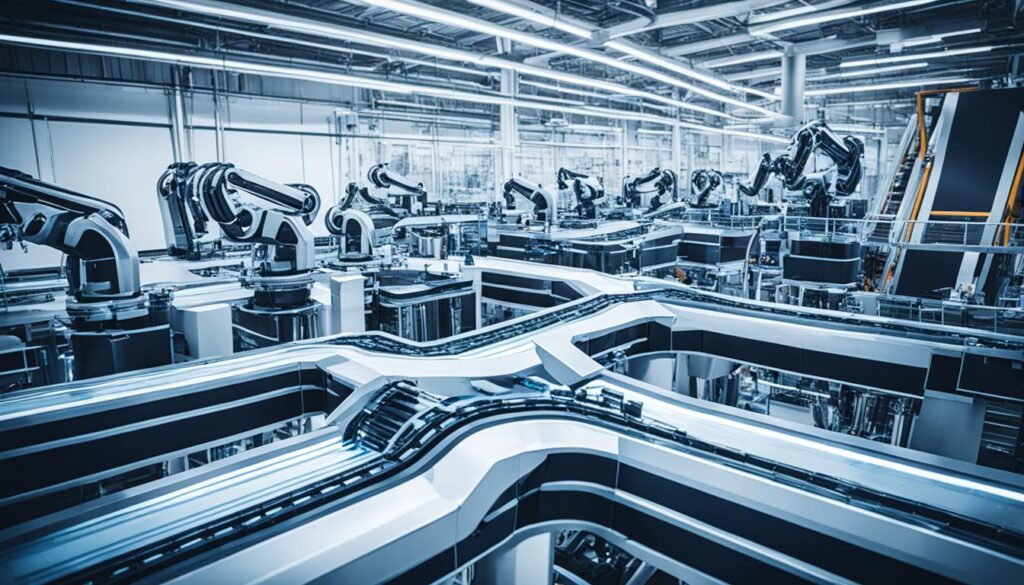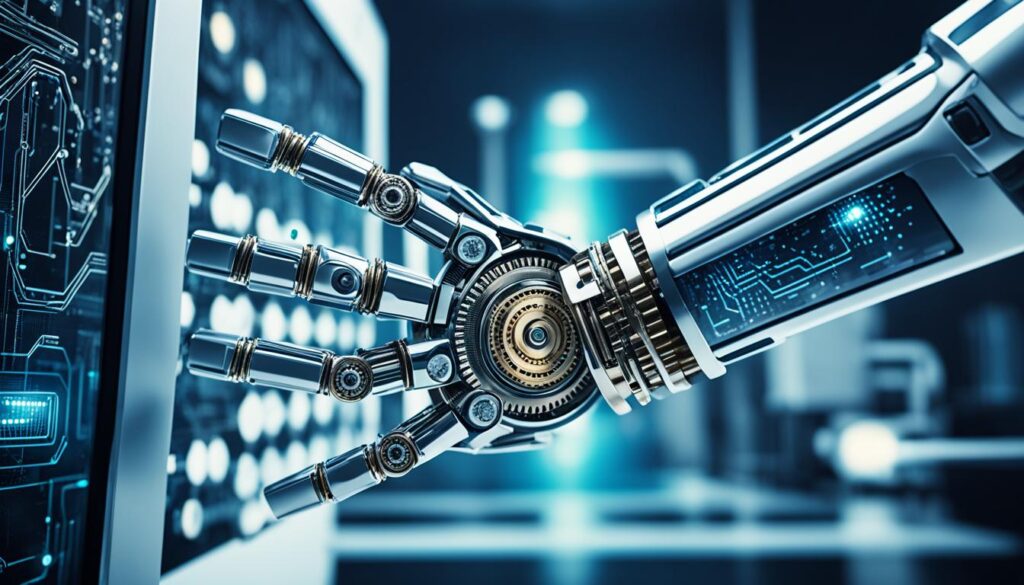In today’s fast-paced business world, making workflows efficient is key. Thanks to artificial intelligence (AI), we can now automate workflows better than ever. This has made businesses more productive, cut down on mistakes, and improved their operations. We’ll look at the top AI solutions for workflow automation in this guide. You’ll see how they can change your business for the better and help you succeed.
Key Takeaways
- Discover the power of AI-driven workflow automation to improve business efficiency
- Understand the benefits of integrating AI into your workflow processes
- Learn about the latest AI technologies transforming workflow management
- Explore best practices for implementing AI-powered workflow automation
- Gain insights into how leading organizations are leveraging AI to streamline operations
What is AI Workflow Automation?
In today’s fast-paced business world, companies are looking for ways to make things run smoother and work better. AI workflow automation is a big step forward. It helps businesses automate tasks, make better decisions, and manage data more efficiently. By using AI, like machine learning and natural language processing, companies can do more with less effort and boost productivity.
Understanding the Concept
AI workflow automation means adding AI to business processes. This lets companies automate tasks like data entry, document processing, customer service, and decision-making. By doing these tasks automatically, businesses save time and effort. This means employees can focus on important, creative work, making the company more efficient and productive.
Benefits of AI-powered Workflow Automation
- Increased Productivity: AI workflow automation cuts down the time and effort needed for repetitive tasks. This lets employees focus on more important work.
- Reduced Errors: AI systems are very accurate when processing data and making decisions. This lowers the chance of mistakes that people might make.
- Improved Decision-making: AI looks at lots of data to find patterns and insights. This helps make better decisions within a company.
- Enhanced Scalability: As businesses grow or change, AI workflow automation can adjust easily. This keeps operations running smoothly and efficiently.
Using ai workflow solutions, ai automation tools, and ai task automation, companies can achieve new levels of efficiency and competitiveness. This helps them stay ahead in a fast-changing business world.
Best AI in Workflow Automation
The need for smart automation is growing fast. Many AI solutions have come up to help businesses in different fields. We’ll look at the top AI tools and platforms that lead in workflow automation. We’ll see what makes them special, what they can do, and how they work in real life.
Microsoft Power Automate is a top AI tool for automating workflows. It lets users make their own workflows, automate boring tasks, and bring together data from different places. The AI Builder feature in Power Automate helps users build AI models and add them to their workflows. This makes processes smoother and boosts workflow efficiency.
Automation Anywhere is another great choice for best ai in workflow automation. It’s an AI-powered RPA solution that helps automate many tasks, like data entry and document handling. The IQ Bot uses computer vision and natural language processing to smartly find and process information. This makes ai workflow efficiency much better.
Watson Orchestrate from IBM is also a top pick in best ai in workflow automation. It combines automation, task management, and AI to help businesses run smoother and make better decisions. Watson Orchestrate can learn and get better over time. This makes it a strong tool for improving workflow efficiency and speed.
“AI-powered workflow automation has become a game-changer for businesses, enabling them to streamline their operations, enhance productivity, and stay ahead of the competition.”
The AI world is always changing, and we’ll see more new solutions for best ai in workflow automation. These advanced technologies let businesses reach new levels of ai workflow efficiency. They help businesses succeed in the long run.
Intelligent Automation: Revolutionizing Business Processes
Intelligent automation is changing how businesses work. It uses robotic process automation (RPA) and machine learning. This makes operations smoother, cuts costs, and boosts efficiency.
Robotic Process Automation (RPA)
Robotic process automation (RPA) changes the game by automating simple, rule-based tasks. RPA bots act like humans, doing tasks from data entry to document processing. This lets employees focus on important work.
Automating these tasks makes businesses more accurate, productive, and customer-friendly.
Machine Learning and Predictive Analytics
Machine learning and predictive analytics are also changing business processes. They help make better decisions, see challenges ahead, and improve workflows. By looking at lots of data, machines learn patterns, predict outcomes, and offer insights for better processes.
Together, RPA and machine learning form ai process optimization. This smart automation helps businesses streamline, reduce mistakes, and make smart decisions. It boosts productivity and competitiveness.
“Intelligent automation, powered by AI and machine learning, is transforming the way businesses approach their workflows.”
Using ai-powered process orchestration, companies can fully improve their processes. This leads to more efficiency, savings, and better customer experiences. As the need for intelligent automation grows, forward-thinking companies are leading this change.
AI Workflow Solutions: Enhancing Efficiency
AI-powered solutions are changing the game in workflow automation. They use advanced algorithms and machine learning to automate tasks. This includes everything from document processing to decision-making. By using the best ai workflow solutions, companies can do more with less, stay ahead in the market, and boost productivity.
AI workflow solutions make repetitive tasks disappear. This means more time for important work and less manual effort. They also use predictive analytics to adjust to business needs on the fly.
These solutions are smart at sorting tasks by importance. They look at data and user habits to find the most urgent tasks. Then, they send these tasks to the right people or teams. This makes companies more productive and helps them make better decisions.
| Key Features of AI Workflow Solutions | Benefits to Organizations |
|---|---|
|
|
Using ai workflow solutions, companies can make their operations smoother and decisions better. As more companies adopt these technologies, the possibilities for improving workflows and efficiency are endless.

“The true value of AI-powered workflow solutions lies in their ability to automate tedious tasks, freeing up our teams to focus on more strategic and innovative work.”
AI Automation Tools: Streamlining Tasks
Today, businesses are turning to AI-powered automation tools to change how they work every day. These smart tools are key to making tasks easier and more efficient. They help companies work better and do more with less.
Automating Repetitive Tasks
AI automation tools are great at taking over boring, time-wasting tasks. They can do everything from entering data to sending emails. This lets people focus on important work that needs creativity and thought.
AI-powered Task Prioritization
These tools also help figure out what tasks are most important. They look at data and see what needs to be done first. This way, companies can use their resources wisely and get things done faster.
Using ai automation tools and ai task automation helps businesses work better and make fewer mistakes. As more companies use these new technologies, those that adopt AI will be ahead in the digital world.
“Automation is not just about doing things faster or cheaper. It’s about doing things better, smarter, and more efficiently.”
AI Process Optimization: Maximizing Productivity
AI has changed the game in workflow automation. It uses advanced analytics and machine learning to make businesses run smoother. This approach helps companies understand their operations better, spot problems, and make smart changes to improve.
By using AI, businesses can see how work flows and find ways to make it better. This leads to more efficiency and growth over time. It’s like having a superpower for your business.
Process Mining and Analysis
Process mining is key to AI’s power in optimizing processes. It looks at real-time data to understand how things work. This helps companies spot what’s not working well and make changes to improve.
AI and process mining together find hidden trends and predict problems before they happen. They automate tasks that take up too much time. This makes employees happier and more productive, as they can focus on important tasks.
| Key Benefits of AI Process Optimization | Impact on Productivity |
|---|---|
| Identifying process bottlenecks | Streamline workflows and eliminate waste |
| Automating repetitive tasks | Increase employee productivity and engagement |
| Predictive analytics and forecasting | Proactive decision-making and risk mitigation |
| Continuous process improvement | Sustained productivity gains and competitive advantage |
Using AI to optimize processes opens up new chances for growth and success. It brings together data insights and automation to boost productivity. This makes businesses more competitive and sets them up for long-term success.

“AI-powered process optimization is the key to unlocking unprecedented levels of productivity and efficiency in today’s fast-paced business landscape.”
AI-powered Process Orchestration: Seamless Integration
Workflow automation needs systems and technologies to work together smoothly. AI-powered process orchestration helps with this by linking different software, data sources, and business processes. This makes operations run better, cuts down on manual work, and makes sure everything works together well.
Integrating Multiple Systems
AI lets companies connect different systems and tech, making a single digital world. This includes cloud services, IoT devices, and old systems. By linking these, companies can break down data walls, share information better, and work together more effectively.
The main perks of AI in process orchestration are:
- Streamlined data flow and access across the company
- Automated task coordination and handoffs between systems
- Less manual work and fewer mistakes in process steps
- Real-time tracking and monitoring of workflows
- Better decision-making with data insights
This way of connecting systems helps companies use their digital tools better. It boosts efficiency and productivity across the board.
| Feature | Description |
|---|---|
| Intelligent Orchestration | AI algorithms manage tasks across systems and apps, ensuring smooth workflow. |
| Adaptive Integration | The platform adjusts to system changes, data formats, and business needs, keeping integration strong. |
| Centralized Visibility | A single dashboard shows real-time workflow data, helping with data-driven decisions and ongoing improvement. |
Using AI in process orchestration brings new efficiency, speed, and an edge in business operations.
“AI-powered process orchestration is the key to unlocking the full potential of your digital ecosystem, driving seamless integration and operational excellence.”
Implementing AI Workflow Automation
Starting to use AI in business automation is a big step that needs careful planning. It’s not just about picking the right AI tools. It’s also about making sure everyone in the company is on board. We’ll look at what you need to think about and do to make AI work well in your business.
Change Management and Adoption
Adding AI to a company changes how things work. It’s important to manage this change well to make sure everyone is happy and working smoothly together. Here are some tips to help you:
- Talk about the benefits: Explain to your team how AI will make their jobs easier and help them work better.
- Give training: Make sure your team knows how to use the new AI tools by offering training.
- Start small: Try out AI in a small way first to see how it works and get feedback. Then, make it better before using it more widely.
- Give praise: Reward your team for using the new AI tools well. This shows the good changes it brings to the company and encourages others to join in.
Putting a focus on managing change and getting your team to adopt new ways helps make AI a success in your business. This way, you get the most out of automation.
| Key Considerations for Implementing AI Workflow Automation | Best Practices |
|---|---|
| Change Management |
|
| Employee Adoption |
|
By following these tips and focusing on change and getting your team on board, you can make AI automation work well in your business. This will help you grow and succeed in the long run.
Best Practices for AI Workflow Automation
Starting an AI workflow automation journey is exciting but requires careful planning. Following best practices ensures success and keeps your efforts going strong. By using these strategies, businesses can get the most out of AI in their workflows and see lasting success.
One key tip is to make sure your automation goals match your business goals. This means your AI efforts help and improve your main business aims and outcomes.
It’s also smart to focus on automating processes that can save time and money the most. This way, you get a better return on your AI investment.
- Establish a culture of continuous improvement: Encourage your team to always check and improve your AI workflow automation, using feedback to make things better.
- Implement robust governance and monitoring frameworks: Create clear rules, steps, and ways to check how well your AI automation is doing.
| Best Practice | Description |
|---|---|
| Align with Business Objectives | Make sure your AI workflow automation goals help your business’s main goals and what you want to achieve. |
| Prioritize High-Impact Processes | Automate the workflows that can save time and money the most. |
| Foster Continuous Improvement | Get your team to always look at and improve your AI workflow automation, using feedback and what you’ve learned. |
| Establish Robust Governance | Create clear rules, steps, and checks to make sure your AI automation is used right and works well. |
By following these best practices for best practices for ai workflow automation, companies can make the most of AI in their workflows. This leads to sustainable, long-term success.
“Successful AI workflow automation needs a strategic and disciplined approach. It’s all about clear goals, picking what’s important, and always making things better.”
Conclusion
AI has changed the game in workflow automation, making things more efficient and productive for forward-thinking companies. By using the best AI in workflow automation, businesses can make their processes smoother, cut down on manual work, and improve how they operate. This gives them an edge over competitors.
The need for smart automation is growing fast. It’s clear that the best AI in workflow automation will help businesses stay ahead. AI can make decisions better and increase productivity. It’s changing how we handle business tasks, leading to more efficiency and new ideas.
In summary, the best AI in workflow automation is a big chance for companies to reach their full potential. It helps them stay flexible and do well in a changing business world. By taking on this new technology, we can achieve more success and set our businesses up for growth and success over time.
